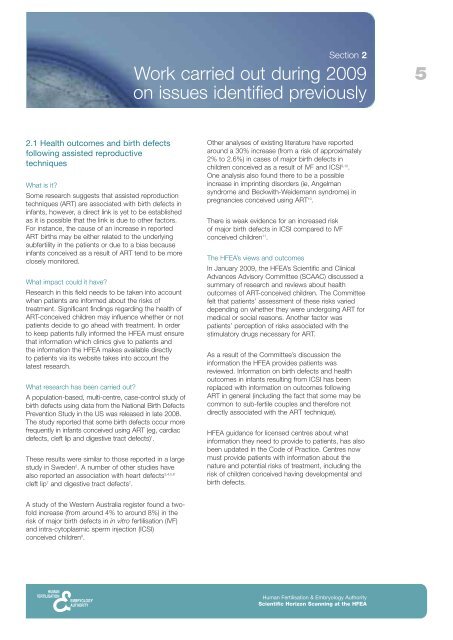Annual report 2009/10 - Human Fertilisation and Embryology Authority
Annual report 2009/10 - Human Fertilisation and Embryology Authority
Annual report 2009/10 - Human Fertilisation and Embryology Authority
You also want an ePaper? Increase the reach of your titles
YUMPU automatically turns print PDFs into web optimized ePapers that Google loves.
Section 2<br />
Work carried out during <strong>2009</strong><br />
on issues identified previously<br />
5<br />
2.1 Health outcomes <strong>and</strong> birth defects<br />
following assisted reproductive<br />
techniques<br />
What is it?<br />
Some research suggests that assisted reproduction<br />
techniques (ART) are associated with birth defects in<br />
infants, however, a direct link is yet to be established<br />
as it is possible that the link is due to other factors.<br />
For instance, the cause of an increase in <strong>report</strong>ed<br />
ART births may be either related to the underlying<br />
subfertility in the patients or due to a bias because<br />
infants conceived as a result of ART tend to be more<br />
closely monitored.<br />
What impact could it have?<br />
Research in this field needs to be taken into account<br />
when patients are informed about the risks of<br />
treatment. Significant findings regarding the health of<br />
ART-conceived children may influence whether or not<br />
patients decide to go ahead with treatment. In order<br />
to keep patients fully informed the HFEA must ensure<br />
that information which clinics give to patients <strong>and</strong><br />
the information the HFEA makes available directly<br />
to patients via its website takes into account the<br />
latest research.<br />
What research has been carried out?<br />
A population-based, multi-centre, case-control study of<br />
birth defects using data from the National Birth Defects<br />
Prevention Study in the US was released in late 2008.<br />
The study <strong>report</strong>ed that some birth defects occur more<br />
frequently in infants conceived using ART (eg, cardiac<br />
defects, cleft lip <strong>and</strong> digestive tract defects) 1 .<br />
These results were similar to those <strong>report</strong>ed in a large<br />
study in Sweden 2 . A number of other studies have<br />
also <strong>report</strong>ed an association with heart defects 3,4,5,6<br />
cleft lip 7 <strong>and</strong> digestive tract defects 7 .<br />
Other analyses of existing literature have <strong>report</strong>ed<br />
around a 30% increase (from a risk of approximately<br />
2% to 2.6%) in cases of major birth defects in<br />
children conceived as a result of IVF <strong>and</strong> ICSI 9,<strong>10</strong> .<br />
One analysis also found there to be a possible<br />
increase in imprinting disorders (ie, Angelman<br />
syndrome <strong>and</strong> Beckwith-Weidemann syndrome) in<br />
pregnancies conceived using ART <strong>10</strong> .<br />
There is weak evidence for an increased risk<br />
of major birth defects in ICSI compared to IVF<br />
conceived children 11 .<br />
The HFEA’s views <strong>and</strong> outcomes<br />
In January <strong>2009</strong>, the HFEA’s Scientific <strong>and</strong> Clinical<br />
Advances Advisory Committee (SCAAC) discussed a<br />
summary of research <strong>and</strong> reviews about health<br />
outcomes of ART-conceived children. The Committee<br />
felt that patients’ assessment of these risks varied<br />
depending on whether they were undergoing ART for<br />
medical or social reasons. Another factor was<br />
patients’ perception of risks associated with the<br />
stimulatory drugs necessary for ART.<br />
As a result of the Committee’s discussion the<br />
information the HFEA provides patients was<br />
reviewed. Information on birth defects <strong>and</strong> health<br />
outcomes in infants resulting from ICSI has been<br />
replaced with information on outcomes following<br />
ART in general (including the fact that some may be<br />
common to sub-fertile couples <strong>and</strong> therefore not<br />
directly associated with the ART technique).<br />
HFEA guidance for licensed centres about what<br />
information they need to provide to patients, has also<br />
been updated in the Code of Practice. Centres now<br />
must provide patients with information about the<br />
nature <strong>and</strong> potential risks of treatment, including the<br />
risk of children conceived having developmental <strong>and</strong><br />
birth defects.<br />
A study of the Western Australia register found a twofold<br />
increase (from around 4% to around 8%) in the<br />
risk of major birth defects in in vitro fertilisation (IVF)<br />
<strong>and</strong> intra-cytoplasmic sperm injection (ICSI)<br />
conceived children 8 .<br />
<strong>Human</strong> <strong>Fertilisation</strong> & <strong>Embryology</strong> <strong>Authority</strong><br />
Scientific Horizon Scanning at the HFEA

















